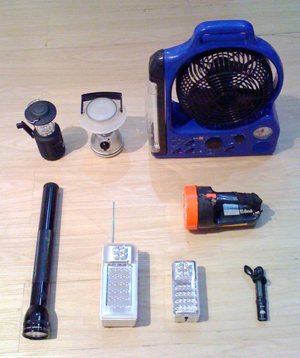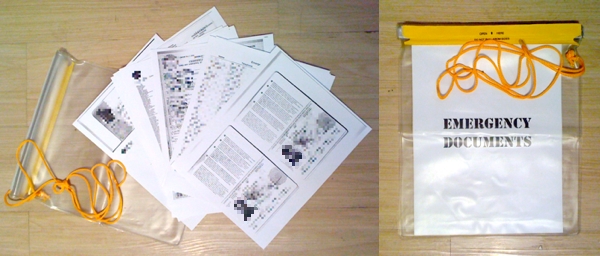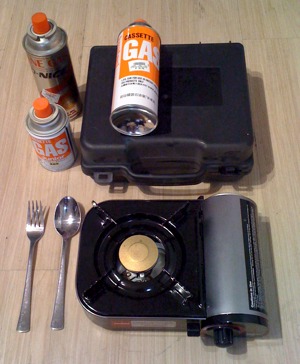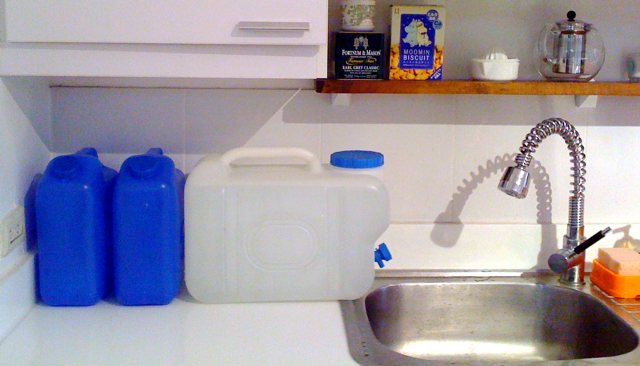During
Typhoon Ondoy, our condo unit was without electricity for almost three days. Although the building was fitted with backup generators, all power was diverted to essential services like elevators and common area emergency lighting.
On the day after power was restored, my wife and I visited Ace Hardware in SM Makati to pick up some supplies and were greeted with a crowd of people panic-buying emergency lighting products. By the time we'd arrived in the early afternoon, Ace Hardware's stock was almost gone. I could only imagine that those poor people had been caught out without lighting during the brown-out and were desperately trying to rectify their mistake. Of course, by then it was too late because Metro Manila had already started to return to normal.
Fortunately, we'd stocked up on a wide range of emergency lighting long before so although we still had to deal with the heat, at least it didn't have to be in the dark. The picture below shows a few of our emergency lighting devices.

These range from plug-in rechargeables to hand-crank,
D-cell, AA-cell and CRE123 powered lights. A few are multi-purpose devices that also include fan, radio, clock and cellphone charger. The lighting elements ranged from
incandescent light bulb,
LED and
CFL.
What I learned
-
Don't wait until the emergency itself to buy your kit. This is so obvious but judging from the crowd in SM Makati's Ace Hardware, many people did just that. Like them, you'll most likely end up scrambling after a dwindling supply.
- By far the most useful technology combination for area lighting turned out to be LED lights with plug-in rechargeable power source. (In the picture, these are the white box-shaped lamps made by Akari and Omni). They were labelled to last between 20 to 120 hours on a single charge and they kept going throughout the three-day power cut.
- For spot lighting, an LED flashlight with CRE123 battery turned out to be the most convenient. (This is the small black flashlight in the picture, a Fenix PD30.) It provided a very bright light with long running time in a tiny package.
- The CFL lights were pretty much useless for anything more than a short-term brown-out; although they cast the most pleasant ambient light, they only lasted a few hours before giving up.
- I didn't bother with the hand-crank light at all. Perhaps it would have been useful in the most desperate case when all other lighting options were exhausted. In this case, I had many other better options.
- The cellphone charge feature on one unit turned out to be very useful.
- The incandescent bulb lamps were far outclassed by all other LED units. With the low price and ready availability of LEDs, I don't think there's any compelling reason to buy an incandescent bulb flashlight or lamp.
Of all the models, the one that most suited the purpose of emergency light was the
Akari Rechargeable Emergency Light (
model AEL 969) which I bought for approx. Php1,100 at Office Warehouse. This included an AM/FM radio, mobile charger and allowed to you switch from four LED (120 hour run time) to 28 LED (50 hour run time).
A few weeks after Typhoon Ondoy, I tested the unit again as I was curious to see how long it would last on a full charge. It ran for almost 5 days before discharging.
I've been told that in emergencies, it's best to have a light that uses a common power source, such as standard C-cell or AA-cell batteries. The reasoning behind this is that their batteries can be stored for longer and it's easier to find replacements; proprietary rechargeable power packs, on the other-hand, need maintenance and are heavily dependent on a power supply to keep them charged.
I do generally agree with this and will always have a few standard flashlights in my kit. However, my experience during Typhoon Ondoy shows that in all but the worst-case scenarios, things would most likely be getting back to normal by the time your rechargeable LED light starts to run down.
Continue Reading




 These range from plug-in rechargeables to hand-crank,
These range from plug-in rechargeables to hand-crank,  The clear plastic jerry can in the picture above holds 20 liters, which is enough to last one person for around 5 days. The blue plastic jerry cans hold just over 6 liters each. These can be purchased from hardware stores like Ace Hardware and True Value. (The 20 liter can was approximately Php300 and the blue 6 liter cans are Php49.)
We also keep additional jerry cans in a cupboard and bottled mineral water in the fridge and pantry, as well as a balde (water bucket) in the shower. In total, I estimate that my wife, baby and I can go almost two weeks just using the stored water in our one-bedroom condo unit.
The clear plastic jerry can in the picture above holds 20 liters, which is enough to last one person for around 5 days. The blue plastic jerry cans hold just over 6 liters each. These can be purchased from hardware stores like Ace Hardware and True Value. (The 20 liter can was approximately Php300 and the blue 6 liter cans are Php49.)
We also keep additional jerry cans in a cupboard and bottled mineral water in the fridge and pantry, as well as a balde (water bucket) in the shower. In total, I estimate that my wife, baby and I can go almost two weeks just using the stored water in our one-bedroom condo unit.